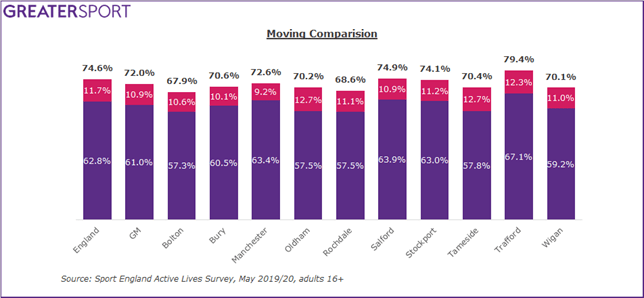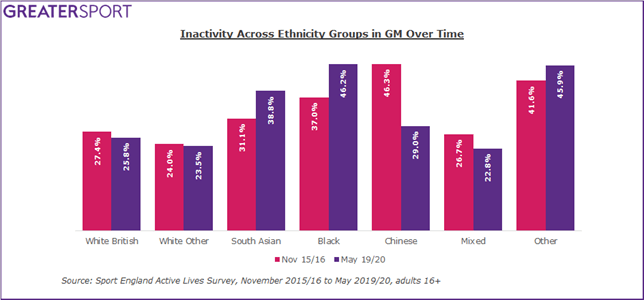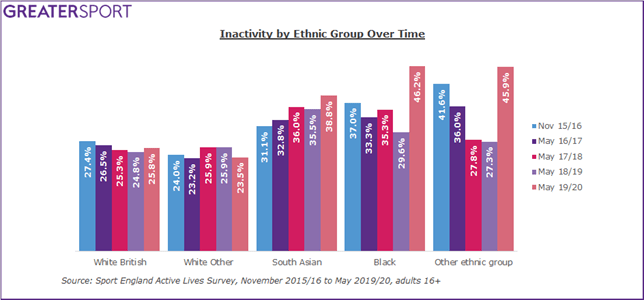Latest data on physical activity across Greater Manchester released
Further data from Sport England's latest Active Lives survey has been analysed exploring the activity levels of Greater Manchester's boroughs and demographic groups
Share
Following the latest Active Lives release from Sport England which covers May 2019 - May 2020 we have now been able to analyse both the Greater Manchester (GM) and borough level data to understand the key differences that exist between different demographics.
Since Active Lives launched in November 2015-16, the proportion of the population moving (active for at least 30 minutes a week) in Greater Manchester has increased by 0.5%, compared to a national increase of 0.1%. Overall, 72.0% of Greater Manchester adults are moving, however this varies considerably between the boroughs; there is an activity gap of 11.5% between Trafford and Bolton, the boroughs with the highest (79.4%) and lowest (67.9%) levels of activity respectively.

It is promising to see that progress is being made again in key inequalities with the gender (-1.2%), disability (-2.6%) and age (-7.3%) inactivity gaps all continuing to narrow since the launch of the survey. Find more detail about the changes to these inactivity gaps across Greater Manchester here.
However, it is particularly concerning to see that the socio-economic gap (+0.8%) has widened, the gap had previously been narrowing, particularly over the last two releases (May 2018/19 and November 2018/19). This highlights the need for us to continue to work across the system to support these population groups, particularly in light of Covid-19 which we know has profoundly impacted many of these groups. More information on how lockdown has impacted Active Lives figures on a national level can be found here. Further research into the impact that coronavirus has had on physical activity can also be found here.
At a borough level, the majority are also showing reduced activity gaps, with the exception of the socio-economic gap:
- Seven of ten have reduced the gender gap
- Seven of eight have reduced the age gap*
- Seven of ten have reduced the disability gap
- Three of eight have reduced the socio-economic gap*
*Some areas did not have enough data for certain demographics at either baseline or in the latest release, this means that the inactivity gap change over this time period can't be calculated.
Inactivity by ethnicity also represents a varied picture. Promisingly, four of the seven ethnic groups that are included within the survey have seen inactivity decline, most notably amongst those from a Chinese background where inactivity has declined by 17.3%. It is however, concerning that three ethnic groups have increased inactivity since November 2015/16; those from a Black background have seen inactivity increase by 9.1%.

It is particularly concerning when the change over the last 12 months is examined. Since the May 2018/19 release just one ethnic group has seen inactivity decline, White Other (-2.4%). Other groups have seen large increases in inactivity, the most concerning being Other ethnic groups and those from Black backgrounds which have seen inactivity rise by 18.6% and 16.6% respectively.

*Full time series data is not available for Chinese and Mixed ethnic groups due to small sample sizes in one or more releases
Greater Manchester is taking forward steps in reducing the inequalities in physical activity levels across the city-region, however the latest official data confirms that there is still more to be done with all demographic inactivity gaps remaining larger than the national figures.
GreaterSport believe that everyone should access the benefits that taking part in sport, physical activity and moving more bring. We cannot ignore the facts that many people with disabilities, older adults, those from less affluent backgrounds, Black, Asian and Minority Ethnic communities all fall well below recommended levels of activity and suffer from poorer outcomes in the areas in which we know sport and physical activity can make a significant difference, to include lower healthy life expectancy.
GreaterSport is committed to making the tackling of inequality a core plank of our new 2021 strategy to create more diverse and inclusive activities that enable everyone to move more and lead healthier and happier lives.
Read the full Greater Manchester activity data here.
You can find the data for each of Greater Manchester's boroughs by following the links below.
Bolton |
Bury |
Manchester |
Oldham |
Rochdale |
|
|
|
|
|
|
Salford |
Stockport |
Tameside |
Trafford |
Wigan |
Latest News

What We’re Learning From Place: Reflections From Across Greater Manchester
Nicole McKeating- Jones our Strategic Lead for Place shares her thoughts on the annual reflections of the Place Partnership work across Greater Manchester.

GM Moving pays tribute to Jo Taylor and her role in GM Moving In Action
As we approach the end of 2025, we wanted to take a moment to reflect on some news we had last month.

Nuffield Health research adds to evidence on benefits of exercise programmes
Research carried out by Nuffield Health, Frontier Economics and Manchester Metropolitan University, shows that expanding their programme would generate at least £1.7bn in social and economic value.
